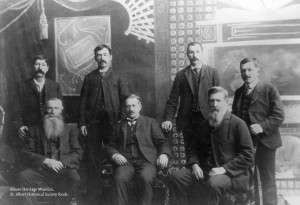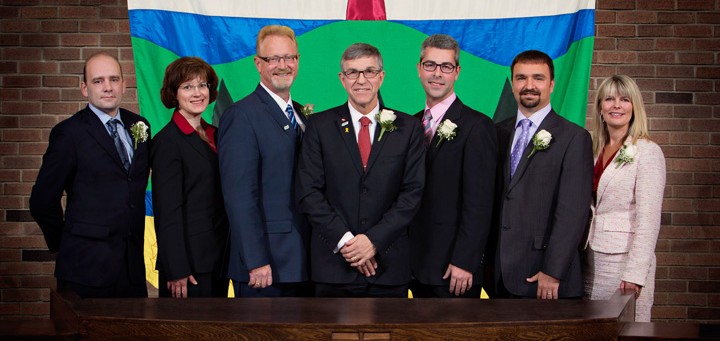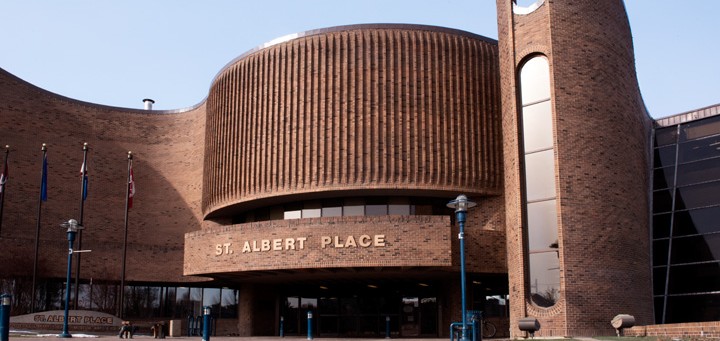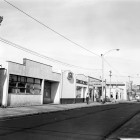Then & Now
St.Albert City Hall
BY DAWN VALENTINE OF VINTAGE ST. ALBERT
December, 2015
In less than 10 years after its founding, St. Albert was home to over 1,000 residents. From a settlement to a village to a town with a mayor, we flourished. As our city took shape, so too did our municipal government, the evidence of which is on the street signs that honour those who have guided us. Here’s a look back at our city hall and mayoral history.
1900s
Cheri Hebert, a successful businessman, served as the first mayor of St. Albert from 1904–1907. Hebert Road is named in his honour.
In 1905, the town office was set up in Lucien Boudreau’s “sample room,” presumably in his Astoria Hotel.
Fleuri Perron, the owner of several St. Albert businesses, served as our second mayor from 1907–1908. Perron Street was renamed after him.
Lucien Boudreau, our mayor in 1909, was the only member of the provincial Parliament to vote against the Alberta Equal Suffrage Act in 1916, arguing that “The place of women was in the home.” Boudreau Road is named for him.
Between 1908 and 1910, the town office moved into the 1888 police barracks, a two-story log building on St. Anne Street. When this building was taken down in 1939, the logs were used to build a home on Taché Street. Remarkably, this cabin is still standing, having been moved just east of St. Albert Trail near the river. It has been used in recent years as the Summer Nature Centre.
1910s
Herbert B. Dawson (Mayor 1910) opened a store in the Dawson Block, which he constructed in 1906. Dawson Road was named after him.
Leon Levasseur (Mayor 1911–1912) was chairman of the school board in 1909 and owned Levasseur Royal Livery. Levasseur Road was named for him.
Dr. J. Arthur Giroux (Mayor 1913–1918) was St. Albert’s first medical officer and practiced medicine out of his home for more than 30 years. Juneau House, named for its first owner, is said to be haunted by the ghost of Dr. Giroux. Giroux Road is named in his honour.
Alex Perron (Mayor 1918–1919) was a son of Fleuri Perron.
Michael Hogan (Mayor 1919–1943) took office at a time when the finances were struggling. In efforts to improve the situation, he unloaded the one policeman and decreased teacher salaries. He was our mayor for a record-holding 24 years and died in office. Hogan Road was named after him.
1940s
Dr. Richard Poirier (Mayor 1943–1945) was St. Albert’s health officer. Poirier Avenue is named for him.
John E. LeClair (Mayor 1945–1946) was known for his philanthropy. LeClair Way was named in his honour.
Eugene Maheux (Mayor 1946–1947) was a long-time resident who also ran one of the garages in town.
Neil M. Ross (Mayor 1947–1951) owned Ross Truck Service and donated the statue of the Virgin Mary that stands in the Grotto at St. Albert Parish. Both Neil Ross Road and Neil M. Ross Catholic School were named after him.
1950s
William Veness (Mayor 1951–1957) saw St. Albert’s population grow to 10,000 people during his tenure. Veness Road was named after him.
In 1957, St. Albert was part of the Provincial Government’s New Town Act, where financial assistance was provided to towns coping with the strains of growth. There was no mayor during this time; the town was run by a board of administrators.
1960s
In 1961, the New Town Hall opened on Grandin Road and McKenney Avenue (now Sir Winston Churchill Avenue). Designed by architects Hemingway and Laubenthal, the building had an impressive view of Mission Hill.
In 1962, the New Town of St. Albert reverted back to a regular town.
William Veness served a second term as mayor from 1962–1965.
John de Bruijn (Mayor 1965) was an alderman under both Mayor Veness and Mayor Gibbon.
Dick Fowler (Mayor 1965–1968) went on to earn two degrees at the University of Alberta after his first term as mayor. He also served more than 10 years as a provincial court judge. Richard S. Fowler Catholic Junior High School, Fowler Athletic Park and Fowler Way were all named for him.
Ray Gibbon (Mayor 1968–1974) lost his bid for town council in 1964 but successfully challenged the result in court, alleging problems at the polling stations. The mayor and councillors who were voted in were ruled ineligible, and a new election was held the next year. Ray Gibbon Drive was named for him.
1970s
Richard Plain (Mayor 1974–1977) banned smoking in all places of business and initiated plans for a multi-purpose leisure centre that 30 years later became Servus Place.
On January 1, 1977, St. Albert (Alberta’s largest town) became the province’s eleventh city.
Ronald Harvey (Mayor 1977–1980) became the namesake of Ronald H. Harvey Elementary School.
1980s
Dick Fowler served a second term as mayor from 1980–1989.
In 1984, the newly completed St. Albert Place became home to City Hall, the Public Library, Musée Héritage Museum and the Arden Theatre. Designed by Canadian architect Douglas Cardinal, the building’s curves flow alongside the Sturgeon River.
Ray Gibbon served a second term as mayor in 1989.
Anita Ratchinsky (Mayor 1989–1998) was the founding chair of the Capital Region Waste Minimization Advisory Committee. She also approved the building of the Perron Street Clock Tower, one of St. Albert’s most recognizable landmarks.
1990s
Paul Chalifoux (Mayor 1998–2001) was elected when the main issue was the alignment of the West Regional Road, which eventually became Ray Gibbon Drive. He also increased St. Albert’s size by 35 percent with a major land annexation.
2000s
Richard Plain served a second term as mayor from 2001–2004.
Paul Chalifoux served his second mayoral term from 2004–2007.
Nolan Crouse (Mayor 2007–present) has a background in the Forest Products Industry. He has long been involved in hockey with the Alberta Junior Hockey League, as well as aiding the Winter Games and the United Way.
In 2014, the east boardroom at St. Albert Place was renamed the Douglas Cardinal Boardroom, after the building’s architect.
Now
The sixth largest city in Alberta, St. Albert has grown to include over 63,000 residents. It has been ranked one of the top places to live and raise a family in Canada. Thanks to its meandering river, ravines, trails and a plethora of public art, it is now known as The Botanical Arts City. The iconic St. Albert Place is symbolic of a city keeping up with the times while remembering its roots t8n
Did You Know? The Perron Street Clock Tower was intended to be a leaning tower! This did not sit well with City Council, as they felt the citizens of St. Albert would not approve. After things were straightened out, four ornamental gargoyles were donated by Hole’s Greenhouses & Gardens. Now the main concern is that all four clocks tell the same time.

Archival Photo Credit Musée Héritage Museum, St. Albert Historical Society fonds, 2003.01.791















